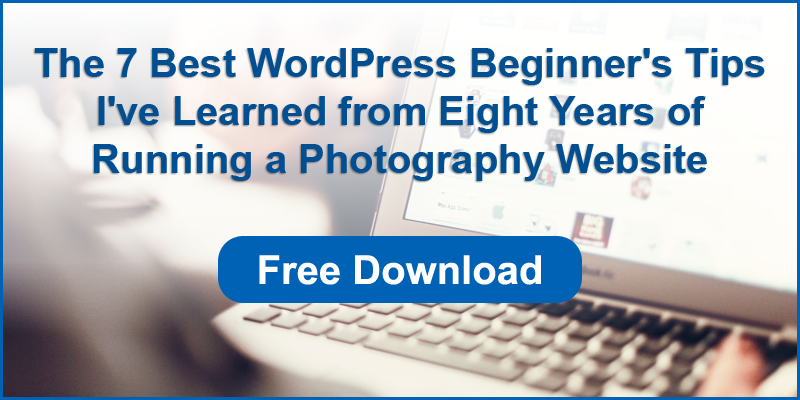If you’ve read any of my business posts or podcasts, you’ll know that I highly rate Facebook and Twitter. They are incredible marketing tools for professional photographers.
But, if you’re looking to make good money from photography, you must have your own website to really harness the power of Facebook and Twitter.
In this article I’ll explain the best way to build a beautiful looking website for your photography business that’s based on sound business principles.
Then I’ll give you an alternative way. A back-up solution that’s easy for photographers and very affordable.
Why Social Media Isn’t Enough

Social media sites are brilliant for getting your work shared. Their advertising platforms are awesome (if used correctly). As a professional I wouldn’t be without Facebook, Twitter or Instgram.
Q. Do you know what the trouble with ALL social media sites is?
Once your potential customer has had a quick glance of your post, they’re off to watch a video of cats or to stalk that guy their friend has just started dating.
Then there’s the ads. You can’t get past them. Facebook, Twitter and Instagram are deliberately trying to move your potential clients away from your stuff and toward the guy who’s paid them.
On social media your potential clients aren’t engaged with your work.
My Friend the Doctor

A good friend of mine spent seven years gaining a Doctorate (PhD). It doesn’t normally take that long but she battled though serious illness and relationship breakdown to get there.
She says it was the most stressful time of her life.
Soon after finishing her course she received a Charge Card though the mail and her name had the title “Dr” before it.
She immediately phoned and told me that seeing her Dr title burnt in to the plastic made it all worthwhile!
I was the same when I registered my studio’s website name.
Seeing my name on a www. address made me feel that I’d made it.
Your own www. address looks professional.
People take you more seriously. It looks great on your business cards.
And you also get the ability to have a great looking email address. The free services such as gmail and Hotmail are great. But if your business cards show an email address that everyone knows is free, it screams AMATEUR.
Something like [email protected] looks so much better.
It’s All About Having Control

Do you remember a few years ago when Facebook made a major change to its design?
EVERYONE was in uproar!
There was post after post of complaint about how everyone hated it and how confusing it was. There were even people saying they’d leave.
With social media, they control the look of the site. They choose whether your work appears in the newsfeed. They pick what is shown above, below and alongside your work. They choose the size, the cropping and the surrounding page colors.
With your own website: what people see, how it’s laid out and how it’s organized is all under your control.
How to Get One

There are dozens (hundreds probably) of ways to build a website.
I’ve tried quite a few: from writing raw html to buying very expensive software.
I’ve come to a conclusion.
If you don’t like my conclusion, I have a back-up plan: a cheap, easy to use, great looking way to build websites. I’ll tell you about that further down.
First, my opinion: the best way for a solo professional photographer to build a great looking website for their studio is to have someone else build it for them.
Why? The job of a solo photographer is to market their business and take photos. Anything that distracts them from those two jobs is robbing them of income and business growth.
However, I understand that there are disadvantages to that approach. From my own experience, here are a few:
- It can cost a fortune to have a pro design your website
- Making changes, even just a few words, can be expensive
- Someone else has the passwords and they may not give them to you
- A re-design can cost as much (or more) than the initial launch
- If you want to move your website to another design company (or another software system) it can be very time consuming and expensive
- If you use a solo web designer, if the designer is ill the updates don’t get done
- Even with a large design agency, you don’t control when the updates happen—sometimes a change you need to happen NOW may take days to be done for you

Do It Yourself?

The great news is that you can do it yourself. The costs are very low, it’s easy to do and, if you do it right, you can still end up with a beautiful, very professional looking website.
By doing it yourself you leave behind the frustration of unreliable updates, high on-going costs and potential password/access issues.
About eight years ago, after years of battling with these issues, I decided to take control: to build and run my website myself.
I did a lot of research. I tried a lot of methods. I made a fair few mistakes.
The breakthrough came when I downloaded some FREE software.
In less than one day I had a BEAUTIFUL, professional looking website that I could update any time I wanted. I had all the passwords. There was no problem moving my site to a different service provider if I ever wanted to. And I soon taught other people to update it for me so that I could delegate the task.
Which System?
Have I tested every single way to build a website? No. There are way too many.
What I did was try enough until I found the one that worked really well. I love it. I’m sticking with it.
Here’s a rundown of what I’ve tried.
Desktop Software
So there’s software that you install on your Mac or PC that lets you build a website in a similar way to the way you write reports. Type the text. Drag and drop images. Upload the result on to the Internet.
I’m talking the sort of software that costs hundreds of Dollars and takes weeks/months to learn.
I’ve tried it.
For me: Too difficult. Too expensive.
Site Builders
There are websites that let you build websites.
You pay them a monthly or annual fee. Log on. Type, drag, drop and press Save.
I’ve tried them. They work quite well. I like them.
But they have two MAJOR drawbacks as far as I’m concerned.
- They have much higher costs per month than the system I use. Some of them have optional extras that you’d think would be included (like having an email address). Add up all the costs and it isn’t cheap.
- If I’m unhappy with their service, I’m tied in to using them. There’s no way that I can take my website and go. As soon as I stop paying them, my website goes down and I need to quickly find a new system and set up every page of my website again from scratch.
CMS
I use a type of website building system known as a CMS. There are lots of them.
I like to think I’ve found the easiest one to use and the best.
What I love about the CMS that I use is:
- The software is free, high quality and constantly improving
- It’s easy to setup, easy to use and easy to update
- If I get bored with the way my website looks, changing it is easy and quick
- I can update it any time I want
- I can authorize my staff to update it for me—and I can limit what they are allowed to do
- The costs to keep it on the Internet are amazingly cheap—like less than $5 a month. And if the company I use to store it for me increase their prices (or I’m unhappy with their service) it’s easy to move my website to someone else.
What’s even more impressive is who else uses this same system. The same software is used by over 1 in 4 of all the world’s websites, including:
- The New Yorker
- BBC America
- Variety
- Sony Music
- MTV News
I’ve been using it now for over eight years: I love it and I have no intension of changing.
If you’d like my free guide “The 7 Best WordPress Beginner’s Tips I’ve Learned from Eight Years of Running a Photography Website”, click the button below.
[thrive_2step id=’3824′]

